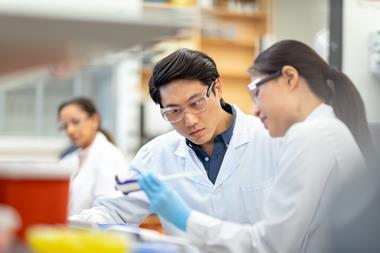Emma Davies finds out how Phosphonics is capitalising on designer functionalised materials that capture and catalyse with tailor-made chemistry
David Astles, chief executive of UK company Phosphonics, is excited about the future. Revenues are growing for the company, which specialises in developing functionalised inorganic materials for applications ranging from precious metals recovery to catalysis. ‘We have moved out of being a typical spin-out, living hand-to-mouth as we did in the early days when we had to beg or borrow equipment,’ says Astles.
To get to this stage has required much ‘hard graft,’ he adds. ‘Everything takes longer than you think it will. The technical development takes longer, the scale-up takes longer, and just getting companies to accept you as a new player takes longer,’ he says. ‘We have now done our spade work. We have broken into a number of markets and have been accepted by major companies all over the world.’
Phosphonics was spun out of Queen Mary, University of London in 2003, with technology developed by inorganic chemist Alice Sullivan, moving to Oxford’s Milton Science Park in 2006. Sullivan discovered a way to decorate inorganic materials with functionalised silanes, giving a general and low-cost means to functionalise inorganic materials. One of the first products used phosphonic acids, giving rise to the company name.
Phosphonics has a chemistry core, with a platform technology consisting of a wide range of ligands anchored to solid inorganic materials, typically silica. The molecules can act as catalysts or scavenge targeted metals. ‘We can functionalise silica using a one-pot method,’ explains James Ward, business development manager at Phosphonics. Each material has a carefully selected functional group, often containing a heteroatom such as phosphorus or sulfur. Rings and carbon chain spacers in the molecules help to define the shape of the molecules and increase their activity. The internal heteroatom and the functional groups can be set up to work together in a coordinated manner to grab hold of metals during scavenging.
Highly refined
The technology is currently supplied for use in precious metal recovery systems for the mining industry, as immobilised catalysts and as a purification tool for the pharmaceutical and fine chemicals industries. Low concentrations of precious metals such as platinum, rhodium, and palladium in mining waste streams can be recovered by passing them through columns packed with the functionalised silica. For example, such columns can take the concentration of platinum in a waste stream from 10ppm down to 1ppm, explains Ward.
Pharmaceutical companies rely heavily on palladium catalysis for active pharmaceutical ingredient (API) synthesis, particularly for carbon-carbon bond formation reactions such as Suzuki couplings. They are bound by regulations to limit the concentrations of palladium in final drug substances and traditional methods for removing metals from APIs such as distillation, extraction, or crystallisation can lead to product loss. Phosphonics’ technology can be used at room temperature to scavenge palladium with little or no product loss.
Engineering expertise
Phosphonics is now building its engineering expertise so that it can offer ‘pre-engineered solutions’ says Ward. Instead of simply selling the functionalised silica to industry, the plan is to sell an entire package, which includes the engineering required to insert the technology into processes. Having previously worked in the pharmaceutical industry, Ward relishes the focus on engineering. ‘There, engineering is enabling but it isn’t what the business is - if you come up with a great engineering solution but the drug doesn’t work, you’re not going to have a product. With Phosphonics, chemistry and engineering are what the business is,’ he says.
‘At our heart, it’s the novel materials that make our company what it is, but the deployment of those materials and solving problems are really critical,’ agrees Astles. The technology also has other potential applications, he adds, from biological materials to new areas of catalysis. ‘Catalysis could be a major area for us,’ he predicts.
Phosphonics currently employs about 25 people, many of whom are PhD chemists. And those employees need to be highly flexible - most work on varied projects and interact regularly with customers. ‘Phosphonics is still entrepreneurial,’ says Astles. ‘It suits people with a willingness to dive in, take some risks and try lots of things.’
Emma Davies is a science writer based in Bishop’s Stortford, UK












No comments yet